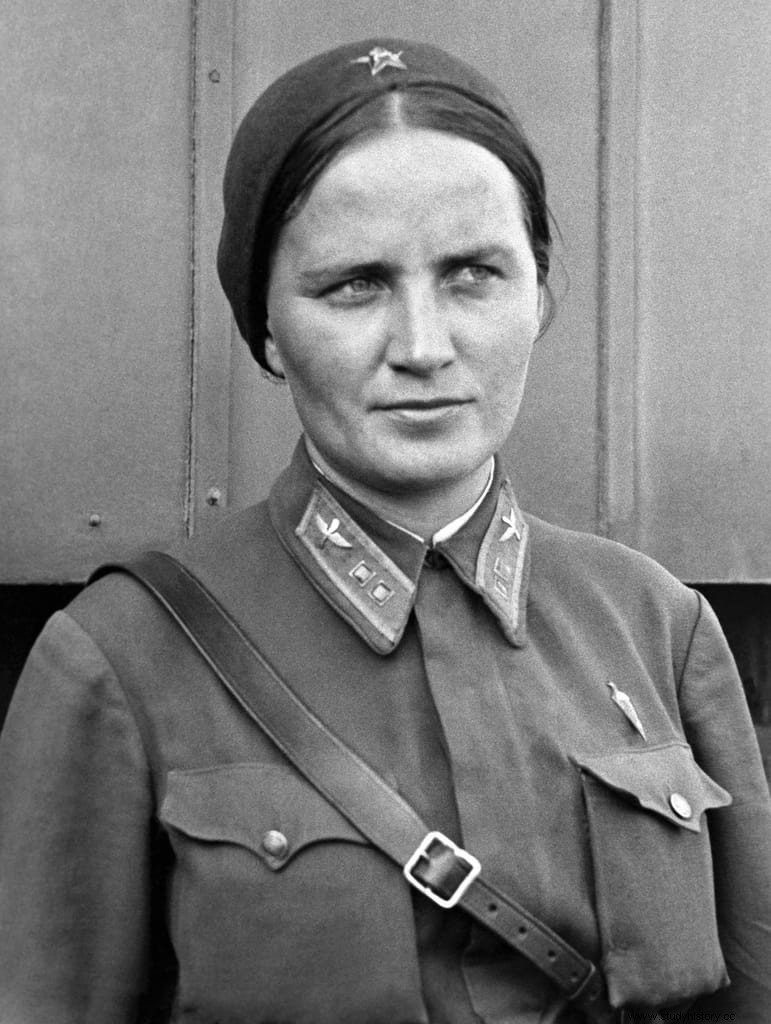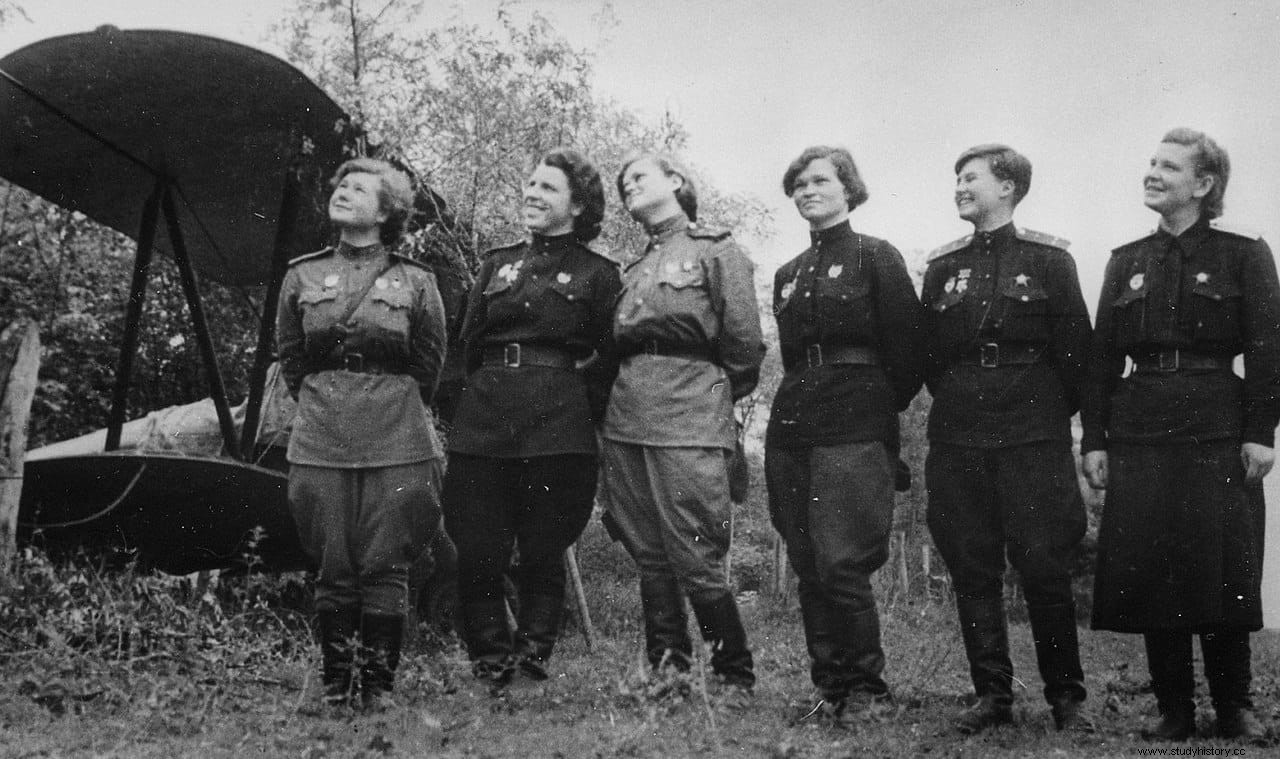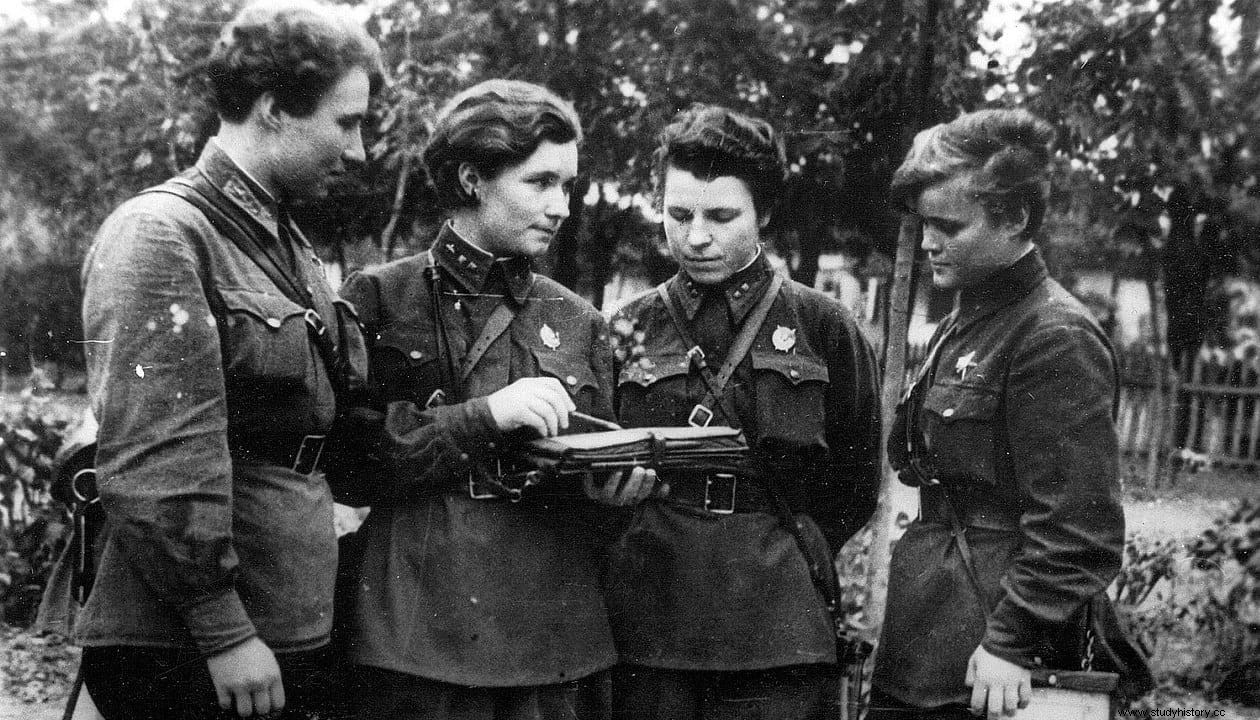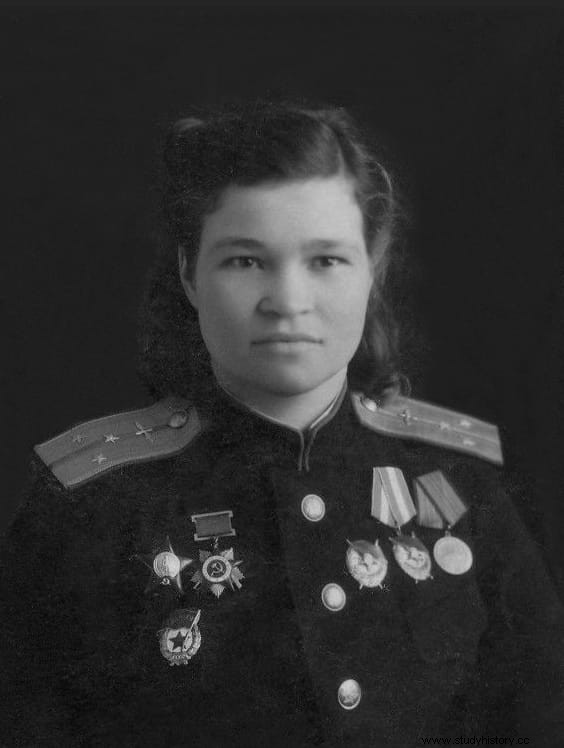Most of the songs of Sabaton, a famous Swedish heavy metal band , deviate from the usual theme of music to tell war stories:from the battles fought by King Charles VII to the Gulf War, through the attack of the Polish winged hussars on the Ottomans in Vienna, the Charge of the Brigade Light and many more. On his album Heroes (2014) dedicate one to the 588th Night Bombardment Regiment, which had the peculiarity of being made up exclusively of women. The Germans called them Die Nachthexen , the Witches of the Night.
Except for a first revolutionary moment in 1917, in which Kerensky created several female battalions, Soviet women were initially unable to go to the front to fight. The only attempt that had been made in this sense was in the Spanish Civil War, when the militia women obtained authorization to enlist based on the example they had given in strikes and demonstrations, as well as in the Revolution of 1934, conquest apart from historical rights ( vote, divorce, political militancy). However, her presence in the front line was uncomfortable for the commanders and leaders, who ended up decreeing her demobilization in 1937.
That is why when the Great Patriotic War broke out, the name given in the USSR to the fight against the German invasion (that is, the eastern front of World War II), women could only join military units in positions that were not required to enter combat, the majority being sent to health. But that was in June. Four months later, with Leningrad under siege and the Wehrmacht detained in extremis At the cost of heavy casualties that had to be supplied as soon as possible, the situation changed.

Although the majority continued to collaborate with work outside the war sector (industry, transport, agriculture), the military advantages that the thousands of volunteers who had offered themselves could provide were reconsidered and officially October was the month in which the doors were opened to that women could fight like men. It is difficult to say exactly who had the honor of being the first; Zoya Kosmodemyanskaya, a high school student who joined a partisan group in October, is traditionally named. Soon there would be women tankers, snipers, sappers...
On the 8th of that same month, Stalin issued an order to organize three all-female air regiments, thus agreeing to the request that Marina Raskova had insistently made to alleviate the losses of pilots. She was a young woman from a family dedicated to music who became interested in aviation in 1930, after marrying an engineer, joining the Soviet Air Force three years later and alternating her work as an instructor with achieving flight records. One of them obtained in 1938 when making the Moscow-Komsomolsk route on the Amur in very difficult conditions, because when the fuel ran out, she had to parachute over the taiga to give her companions time to find a place to land in an emergency.
As can be deduced, Marina starred in that episode with a crew made up of two other women:co-pilot Polina Osipenko and commander Valentina Grizodúbova. The three were named the first Heroines of the Soviet Union and Marina was promoted to colonel, in addition to obtaining a leadership position in the Communist Party; The access she had to Stalin is thus understood, although the success of a book she published about her adventures also influenced (she spent ten days traveling alone through the Siberian taiga, feeding on wild fruits, while looking for the place where her companions perched).

This meritorious trio was not unique. In the 1930s, many young Soviet women became interested in aviation and joined flying clubs, schools of the Civil Air Fleet and the OSOAVIAJIM (a union of patriotic societies to prepare the population for the defense of the country and which had aerodromes, radio clubs, shooting ranges, etc), forming a huge potential pool of pilots and navigators. Marina knew this and that is why she got Stalin to found what was temporarily called the 122nd Aviation Corps.
Its base was located in Engels, a city in Saratov Oblast, in central Russia, where training was provided to enlisted volunteers, whose average age was twenty years. After that first phase, the corps was divided into three regiments:the 586th Air Combat, the 588th Night Bombardment and the 587th Bombers. The baptism of fire was received by the first, under the command of Tamara Kazarinova, on April 16, 1942; equipped with Yak 1, Yak 7-B and Yak 9 aircraft, it would carry out 4,419 missions and participate in 125 dogfights, shooting down 38 enemy aircraft.

The third, which in September 1943 would be renamed the 125th Guards Bomber Air Regiment, had Marina as commander until he died that same year, in an accident (his plane fell during a storm) during the siege of Stalingrad.; then command passed to Valentin Markov. Originally, it was made up of obsolete Sukhoi Su-2s that the Navy, before his death, managed to have replaced by modern Petliakov Pe-2s, something that caused resentment in male units that continued to receive outdated aircraft. The regiment carried out 1,134 missions and five of its members earned the title of Heroines of the Soviet Union.
As for the 588th, the most famous regiment, it was led by Colonel Yevdokiya Bershanskaya. Born in 1913, she was raised by her uncle as her parents died during the Civil War that followed the Revolution. In 1931 she enrolled at the Bataysk Pilot School, teaching until 1939. That year she was appointed commander of the 218th Special Operations Aviation Squadron, along with her deputy in Krasnodar. Shortly after she got married and had a son; the marriage was short-lived, but she would find a second husband after World War II.
Her unit was made up of Polikarpov Po-2 planes, old biplanes from the twenties reused for military use due to their abundance (it is one of the models that has built the most units in history); in civilian life they were employed as agricultural fumigators, hence she nicknamed them Kukuruznik (word derived from kukuruza , corn).
The Polikarpov's problem was its obsolescence, which initially meant it only for training. But, with the course of the war and the need for material, it would prove unexpectedly useful. And it is that, despite having only two seats (pilot and gunner), it was very maneuverable and it was not exactly fast, which made it easy to learn to control it right away and reduced the need for flight hours for its users; they called it lastochka (swallow). In addition, the low speed led to a curious paradox that became advantages.

And it is that its slowness was such that the maximum speed it could reach (152 kilometers per hour) was far from the minimum that the German Messerschmitt Bf 109 and Focke-Wulf Fw 190 planes needed to avoid losing lift and falling, so they had enormous difficulties in bringing it down. On the other hand, the Polikarpovs could reduce theirs even more and even turn off the engine in the last section to precise the bombardments, and then start it again. The Germans compared the dull sound of the air rubbing the fabric of the apparatus with that of witches' brooms and thus, according to tradition, the nickname of Night Witches would have been born. .
Of course, the virtues were also flaws and the German ace Josef Kociok scored numerous takedowns. On the other hand, the low altitude at which the Polikarpov had to fly to hit a target (about 400 meters) and its low capacity to load bombs, only two that were dropped by operating a lever or even by hand, forced the aviators to do without. parachute. This was added to the archaic nature of the navigation material they were given, archaic and scarce, since they did not have guns, radio, radar... not even custom-made uniforms, which is why the Raisa mechanics were sentenced to ten years in prison. Kharitonova and Tamara Frolova for using parachute fabric to make underwear.

The template was entirely female, at least if you pay attention to the 0099 order by which the body was created. The reality was slightly different, since in the 587th it was necessary to incorporate men:the upper rear machine gun of the Petlyakov Pe-2 bombers was so high and so heavy (approximately 60 kilos) that it was difficult to find women who could handle it. Likewise, in the 588th, the positions of searchlight operators and some of the drivers were filled with male personnel. We have also seen that Marina Raskova was replaced by an officer of the opposite sex when she died.
The latter also happened with Tamara Kazarinova, but in her case due to her dismissal. Despite being the first female cadet to enter the Leningrad school, flying since 1929 and having the Order of Lenin, a leg injury made her unable to fly and among that, her sour character (which confronted her with Raskova and others) and its low popularity among the troops (they preferred the charismatic one, which, however, was discarded for not belonging to the party and crashed in 1942), met with much criticism. These hatched when he lost several aces on questionable missions, such as Lydia Litvyak, Yekaterina Budanova and, above all, Valeria Khomyakova (who had to fly exhausted), hence Aleksandr Gridnev was sent to relieve her in command of the 586th.
The Witches of the Night, as their name indicates, specialized in nightly bombardments of enemy camps and positions; a work of harassment whose main objective was to psychologically discourage the Germans. At its best, they gathered 40 crews of two aviators each, which added to the rest of the personnel left a total of 261 people. Of them 32 died, some shot down, others due to accidents, many of tuberculosis, losing 28 planes.

Some reached 800 missions, which should not be surprising because each aircraft could not carry more than two bombs at a time (and they also flew in pairs, so that one plane attracted the light of the searchlights and antiaircraft while the other released its burden). But in total they completed some 23,672 departures, between half and a dozen a day on average, depending on whether it was summer or winter, which means that they took off one shift every few minutes, from five to eight minutes, and that allowed them to maintain pressure on their objectives, which, according to calculations, dropped more than 3,000 tons of bombs, both normal and incendiary.
As a result, dozens of bridges, vehicles, railways, fuel depots were hit or destroyed... The German pilot Johannes Steinhoff, one of the great aces of the Luftwaffe (176 shot down!) who took part in Operation Barbarossa under the command of a squadron specialized precisely in night combat, would declare:“It was simply incomprehensible to us that the Soviet pilots who gave us so much trouble were, in fact… women. These women were not afraid of anything:they came night after night, in their rickety planes, preventing us from sleeping…”
A small portion of those flights were transport and supply flights, but most focused on night bombing, as the name of the unit indicated. Name, by the way, that changed twice:the first, in February 1943, when the regiment was sent to the new front line in Belarus and, attached to the 325th Night Bomber Aviation Division of the IV Air Army, passing to being the 46th Guards Night Bomber Aviation Regiment; the second, in October of the following year, when the honorific complement Taman was added. for his participation in the operations carried out on the homonymous peninsula (located in the Sea of Azov).

In Taman, during the spring-summer of 1943, Soviet airwomen made 4,623 sorties, collaborating in the capture of Novorossiysk and the Kuban region. They were almost double the 2,920 credited earlier, in the Battle of the Caucasus (August-December 1942), in which they defended the city of Vladikavkaz and shelled the enemy at Digora, Mozdok and Prokhladny, helping the ground forces cross the Terek River and attack Stavropol in January 43.
Still more sorties were made in November of that year, during the Crimean offensive, 6,140, giving air cover to the infantry in Operation Kerch-Eltigen and Sevastopol. Then they took a "rest" with the 400 of Operation Bagration, in Belarus, bombing the German fortifications that followed the course of the Pronya river and allowing the recovery of Białystok, Cherven, Minsk and Mogilev (June-July 44).
That same summer, in Poland, they came close to the record again with 5,421, joining the Vistula-Óder offensive to expel the enemy from Augustów, Warsaw, Ostrołęka, Gdynia and Gdansk, the latter already in the spring of 45. From there they went to East Prussia, German soil, where they carried out two thousand missions between April and May. It was the swan song because on October 15, once the war was over and its mission fulfilled, the regiment was disbanded.
The legacy she left behind was 23 aviators named Heroes of the Soviet Union, another two Heroines of the Russian Federation, and one Heroine of Kazakhstan. Some went back to college and others went on to work in civil aviation or other jobs, with very few going on to military life. They were no longer witches.
